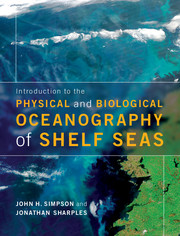Book contents
- Frontmatter
- Contents
- Preface
- Acknowledgements
- Guide to the book and how to make the best use of it
- Symbols
- 1 Introduction to the shelf seas
- 2 Physical forcing of the shelf seas: what drives the motion of ocean?
- 3 Response to forcing: the governing equations and some basic solutions
- 4 Waves, turbulent motions and mixing
- 5 Life in the shelf seas
- 6 Seasonal stratification and the spring bloom
- 7 Interior mixing and phytoplankton survival in stratified environments
- 8 Tidal mixing fronts: their location, dynamics and biological significance
- 9 Regions of freshwater influence (ROFIs)
- 10 The shelf edge system
- 11 Future challenges in shelf seas
- Glossary
- Answers to chapter problems
- References
- Index
- Plate section
4 - Waves, turbulent motions and mixing
Published online by Cambridge University Press: 05 June 2012
- Frontmatter
- Contents
- Preface
- Acknowledgements
- Guide to the book and how to make the best use of it
- Symbols
- 1 Introduction to the shelf seas
- 2 Physical forcing of the shelf seas: what drives the motion of ocean?
- 3 Response to forcing: the governing equations and some basic solutions
- 4 Waves, turbulent motions and mixing
- 5 Life in the shelf seas
- 6 Seasonal stratification and the spring bloom
- 7 Interior mixing and phytoplankton survival in stratified environments
- 8 Tidal mixing fronts: their location, dynamics and biological significance
- 9 Regions of freshwater influence (ROFIs)
- 10 The shelf edge system
- 11 Future challenges in shelf seas
- Glossary
- Answers to chapter problems
- References
- Index
- Plate section
Summary
In this chapter we shall look at waves and turbulence, two forms of motion which are of particular importance in the shelf seas because of their roles in bringing about the mixing which re-distributes properties such as heat, salt, momentum and substances dissolved or suspended in the water. There is a marked contrast in character between the two: waves are generally highly ordered motions which are amenable to precise mathematical description, while turbulence is chaotic in nature and it can usually only be represented in terms of its statistical properties. Both waves and turbulence are large scientific topics in their own right and are the subject of more than a few specialised textbooks. Here, we shall focus on those aspects of surface waves, internal waves and turbulence theory which are necessary to the understanding of processes in shelf seas, and we shall leave the more specialised aspects for the interested student to pursue from the further reading list.
Surface waves
We have already developed the theory of long waves in Chapter 3 from the basic equations and shown how such waves can help us to understand tidal motions in shelf seas. The more general theory of surface wave motions, in which there is no restriction on wavelength, is more involved and a full treatment is beyond the scope of this book. Here we shall simply present the assumptions and the principal results of the theory of infinitesimal waves and give a physical description of the motion involved. As well as being useful in themselves, the results of surface wave theory introduce us to many of the concepts relevant to the understanding of the more complicated motions involved in internal waves.
- Type
- Chapter
- Information
- Publisher: Cambridge University PressPrint publication year: 2012



